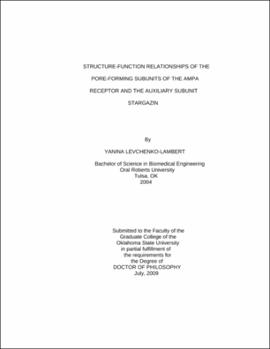| dc.contributor.advisor | Patneau, Doris | |
| dc.contributor.author | Levchenko-Lambert, Yanina | |
| dc.date.accessioned | 2013-11-26T08:22:54Z | |
| dc.date.available | 2013-11-26T08:22:54Z | |
| dc.date.issued | 2009-07 | |
| dc.identifier.uri | https://hdl.handle.net/11244/6653 | |
| dc.description.abstract | AMPA receptors mediate the majority of neurotransmission in the CNS. One of the most important properties of AMPA receptors is their quick and profound desensitization in the presence of glutamate. Although, the mechanism of AMPA receptor desensitization onset has been elucidated and involves breaking of the protein interactions on the dimer interface in response to agonist binding, the mechanism of recovery from desensitization remains unknown. When co-expressed with the auxiliary subunit stargazin AMPA receptor functional properties are affected: steady-state desensitization is decreased, recovery from desensitization is faster, kainate efficacy is increased and deactivation is slowed. The mechanism of stargazin's action on AMPA receptor and their sites of association remain unknown. Previous studies suggested that stargazin decreases AMPA receptor steady-state desensitization by stabilizing the dimer interface. However, in our studies we were able to demonstrate that stargazin's effect on steady-state desensitization in mutations that stabilize the dimer interface is additive, while its effects on steady-state desensitization in a mutant that destabilized the dimer interface is occluded, indicating that stargazin does not act by stabilizing the intra-dimer interface, but instead destabilizes the desensitized state and speeds the recovery from desensitization. To identify residues that may be part of association between the AMPA pore-forming subunits and stargazin we were guided by the homology between AMPA and kainate receptors and the crystal structure of the LBD. We identified residues downstream of helix H (K693 and K695) and in the M4 linker (S784 and A789) that when co-expressed with stargazin presented with loss of it effects, suggesting that these residues may participate in the association with stargazin. Based on our data we were also able to propose a mechanism for recovery from desensitization that includes residues in helix B (K434) and the M1 linker (K501 and K502). Utilizing a similar approach in stargazin we were able to identify areas that are necessary for its association with the AMPA receptors, including polar residues proximal to the plasma membrane in the 1st and 2nd extracellular loops and others that are crucial for its function, the conserved motif GLWXXC and conserved cysteine residues at positions 67 and 77. | |
| dc.format | application/pdf | |
| dc.language | en_US | |
| dc.rights | Copyright is held by the author who has granted the Oklahoma State University Library the non-exclusive right to share this material in its institutional repository. Contact Digital Library Services at lib-dls@okstate.edu or 405-744-9161 for the permission policy on the use, reproduction or distribution of this material. | |
| dc.title | Structure-function relationships of the pore-forming subunits of the AMPA receptor and the auxiliary subunit stargazin | |
| dc.contributor.committeeMember | Miller, Kenneth | |
| dc.contributor.committeeMember | Sawyer, Gregory | |
| dc.contributor.committeeMember | Turetsky, Dorothy | |
| osu.filename | LevchenkoLambert_okstate_0664D_10467.pdf | |
| osu.accesstype | Open Access | |
| dc.type.genre | Dissertation | |
| dc.type.material | Text | |
| dc.subject.keywords | ampa | |
| dc.subject.keywords | desensitization | |
| dc.subject.keywords | stargazin | |
| thesis.degree.discipline | Neuroscience | |
| thesis.degree.grantor | Oklahoma State University | |
